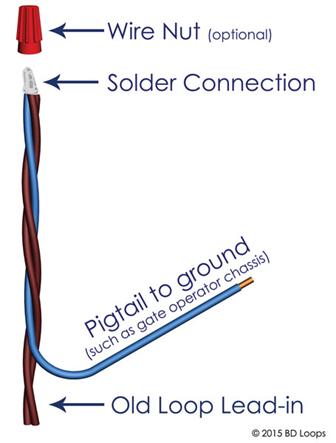Educational Articles
Replacing Old Loops? Read This!
Did you know an old loop in the ground can cause false detections even if it isn’t receiving any power? When installing a new loop over a preexisting loop, it is important to take the necessary steps to prevent headaches later.
When replacing a faulty or failed loop it is important to break up the old loop circuit as much as a possible to prevent false detections and detector lock up. For saw-cut loops you can either cut over the previous loop pattern to tear up the old loop, or take a drill and break up the loop circuit every 2 feet.
If you have an old direct burial loop that is under concrete or asphalt and you cannot pull it out, you can still prevent false detections if you short the old loop lead-in wires by twisting and soldering them together, then ground the old loop with a pigtail to ground. Reset the detector, now that the loop is shorted and grounded it should not cause false detections. You should short and ground saw-cut loops that you are unable to pull up as well.

This is an important procedure to incorporate into your loop replacement installations. After all, you are most likely installing new loops because the old loop is shorting to ground or acting up intermittently. If water gets into the groove of the old loop, the old loop will short to ground and can cause a large change in inductance with the new loop that will lead to false detections and detector lock-up.
We have a video showing how this issue occurs on our YouTube channel, which you can find by searching “BD Loops” on YouTube, or by following the links on our website BDLoops.com.
Below is a more technical explanation of what is happening when an old loop causes false detections on a new loop.
To understand what happens when an old loop causes a false detection we first need to know what causes loop detections. Loops work off of inductance, not magnetism. This is why they are sometimes referred to as inductance loops. This means anything that is a excellent conductor of electricity, such as metal can cause a detection. When current passes through the loop wire an Electric Magnetic Field (EMF) is created around the loop.
Detectors require a percentage of change to trigger a detection, which means that enough metal needs to enter the detection field to cause a detection. When a metal object enters the EMF field created by the loop current, the metal object absorbs some of the EMF fields. Because some of the EMF field is now absorbed, it lowers the resistance (inductance) in the loop circuit which the detector will notice because it is monitoring for a change in inductance. When this happens, the detector will either open or close a relay switch that activates a command in the gate operator such as “open the gate” for exit loop, “reverse the closing gate” for a reverse or safety loop, or “hold open the gate” for a swing gate with a center or shadow loop function. Depending on how sensitive the system is an object as small as a metal trash can lid can cause a detection.
When a new loop is placed over an old failed loop, the old loop shorting to ground will cause a large change in inductance for the new loop which will trigger a very strong detection and can possibly cause the detector to lock up.
This is how an old loop that is not connected to the operator or receiving any power can cause false detections and detector lock-up. These false detections made by the old loop cause many headaches and repeat service calls because it will lead to the gate opening on its own, or being held open. This is a very hard problem to diagnose for most installers since common sense would tell you that the old loop is not receiving power and shouldn’t be causing false detections.
When replacing a faulty or failed loop, it is important to break up the old loop circuit as much as possible to prevent false detections and detector lock ups. For saw-cut loops, you can either cut over the previous pattern to tear out the old loop or take a drill to break up the circuit every two feet. For an old direct burial loop that you can’t pull up, you want to short the lead-in wires by twisting them together, soldering them, and then grounding the loop with a pigtail to ground. When you reset the detector after the old loop is shorted and grounded, it should prevent the old loop(s) from causing any false detections. You should also short and ground saw-cut loops that you aren’t able to pull up.
Follow these simple rules and say goodbye to repeat service calls caused by old loop systems.
BD Loops
The Loop Experts!
BD Loops was founded in 2001. Their preformed loops and accessories are designed with the installer in mind. BD Loops offers a complete loop system solution including preformed direct burial loops, preformed saw-cut loops, loop sealant, blades, testing devices, and installation tools. BD Loops has a reputation for reliability and ease of installation. They pride themselves on the quality of their products and their commitment to providing excellent customer service and support. BD Loops preformed loops are made in the USA at their facility in Placentia, CA.

